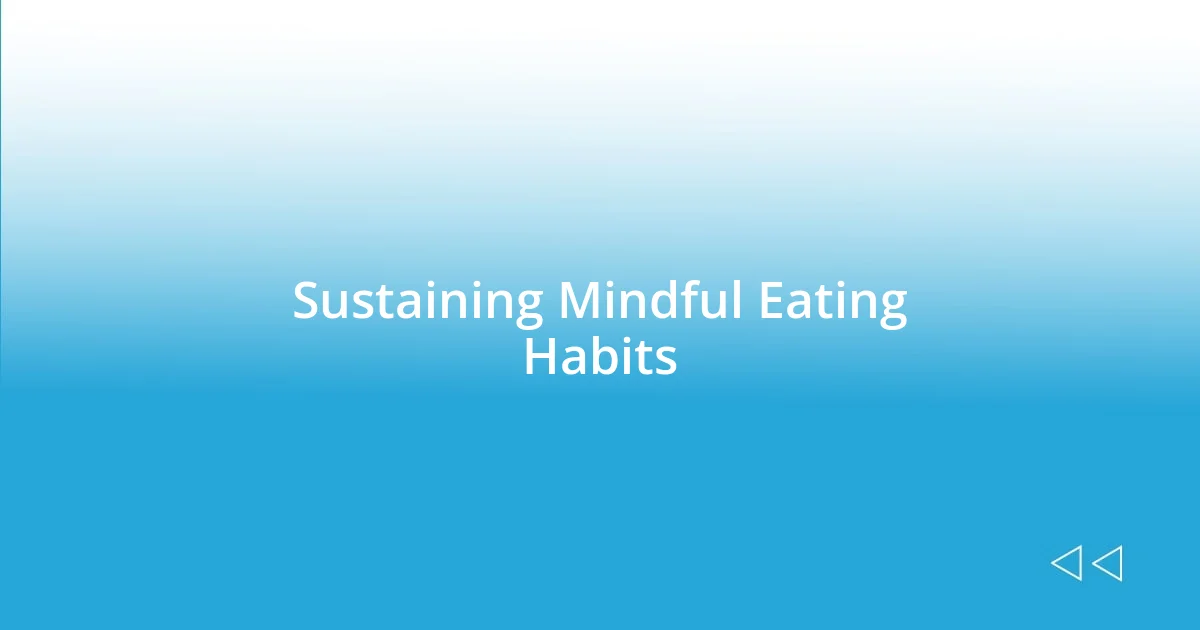Key takeaways:
- Mindful eating enhances awareness of hunger cues and emotional connections, reducing overeating and promoting satisfaction.
- Identifying personal eating triggers through practices like food journaling enables healthier responses to emotions and situations.
- Creating a positive eating environment through silence, decluttering, and ambiance significantly improves the dining experience and fosters mindfulness.

Understanding Mindful Eating Benefits
When I first dove into mindful eating, I quickly discovered its transformative powers on my relationship with food. I remember sitting in my kitchen, taking slow bites of an apple, savoring its crispness and sweetness rather than devouring it mindlessly. That simple act deepened my appreciation for the food itself and helped me realize just how often I rushed through meals.
One of the most profound benefits I’ve experienced is heightened awareness of hunger cues. Before practicing mindful eating, it was easy to eat out of boredom or stress. Now, asking myself, “Am I truly hungry or just responding to emotions?” has become a critical moment of reflection in my day. This awareness not only prevents overeating but also fosters a more profound emotional connection to what sustains me.
Mindful eating has also brought joy back into meal times. I remember a dinner with friends where we shared our favorite dishes, allowing each bite to be a celebration of flavors and textures. This shift from simply filling my stomach to truly enjoying what I’m eating has led to more meaningful dining experiences. How often do we rush through meals without fully appreciating them? Mindful eating invites us to pause and relish every moment.

Identifying My Eating Triggers
Recognizing my eating triggers was a game changer in my journey toward mindful eating. I learned that certain situations or feelings would send me to the snack cupboard without a second thought. For example, after a long day at work, the stress would often lead me to reach for chips—crunching away my frustrations instead of addressing them directly. I realized it wasn’t just about hunger; it was about comfort.
To help with this identification process, I started keeping a food journal, where I recorded not only what I ate but also my emotions at that moment. This practice unveiled a clearer picture of my triggers. Here are some patterns I noticed:
- Stress: After challenging days, I found myself craving high-sugar or high-fat snacks as a quick emotional fix.
- Boredom: Idleness often translated into mindless nibbling, even when I wasn’t hungry.
- Social Situations: I noticed I ate more when surrounded by friends, often motivated by the atmosphere rather than my appetite.
- Celebration: Food was often part of my personal celebrations, leading to overeating during moments that should be enjoyed mindfully.
By pinpointing these triggers, I began to navigate my choices instead of being guided by them. Embracing this awareness allowed me to respond to my feelings with alternatives, such as going for a walk or enjoying a cup of herbal tea when emotions ran high, rather than heading straight for the snacks.

Practicing Awareness During Meals
To truly embrace mindful eating, practicing awareness during meals is essential. I’ve discovered that slowing down transforms my dining experience. When I focus on the texture and flavor of each bite—like the warmth of a freshly baked bread roll—I feel more connected to my food. There’s something profoundly satisfying about recognizing the effort that goes into each meal. It goes beyond nourishment; it becomes a form of gratitude.
Another key insight is tuning into my body’s signals during meals. Recently, I found myself enjoying a family dinner. Halfway through my plate, I paused to check in with my hunger levels. This simple act of self-reflection led me to put down my fork. I realized I was full—not just stuffed, but in a comfortable state of satisfaction. It was a revelation that helped me stop before reaching the point of discomfort, promoting a healthier relationship with food. How often do we forget to listen to our bodies?
During meals, I also incorporate a moment of silence. This may sound unusual, but taking a brief pause before eating has become a ritual for me. I take deep breaths, appreciating the meal laid out before me. Creating this space helps reduce distraction, allowing me to savor the flavors fully. It’s such a small change, yet it completely shifts how I experience food.
| Aspect | Mindful Eating | Mindless Eating |
|---|---|---|
| Awareness | Engaged with food, noticing flavors and textures | Distracted, often consuming without tasting |
| Hunger Signals | Listening to body’s cues for hunger and fullness | Ignoring signals, leading to overeating |
| Emotional Connection | Recognizing feelings associated with eating | Eating as a response to emotions without awareness |

Incorporating Mindful Eating Techniques
Incorporating mindful eating techniques into my daily routine has been a transformative journey. One effective method I adopted is the practice of “eating in silence.” I carve out a few moments before each meal to just be present with my food. It’s surprising how this simple act of pausing can enhance the flavors and aromas I often overlook when distracted. Have you ever noticed how a few moments of stillness can shift your focus? It’s a real eye-opener.
Another technique I found valuable is setting a designated eating space. This was a game changer for me. I learned that creating a special environment encourages a more enjoyable experience, free from the chaos of daily life. When I eat at a designated spot, I find myself more attuned to the food. For instance, I always appreciate my lunchtime salad more when I sit at my kitchen table instead of grazing mindlessly in front of my computer. It’s amazing how ambiance can impact our eating experience.
Lastly, incorporating gratitude into my meals has added a whole new dimension to mindful eating. Before I dive into my food, I take a moment to reflect on where it came from and the effort involved in bringing it to my table. Whether it’s thanking the farmers for their produce or recognizing the time spent cooking, this appreciation deepens my connection to the meal. When was the last time you thought about the journey your food took before it reached you? It’s a simple practice that brings joy to each bite.

Creating a Positive Eating Environment
Creating a positive eating environment has made a significant difference in my mindful eating journey. I remember one evening, dimming the lights and lighting a candle before dinner. That small act transformed my mealtime into a cozy ritual rather than just another task. Have you ever noticed how your surroundings can influence your mood? It’s these details that help me savor each bite more meaningfully.
Another practice that resonated with me is decluttering my eating space. I started clearing the table of distractions, putting away my phone and other gadgets. This intentional choice allows me to focus fully on my meal without the usual interruptions. It’s interesting how removing visual chaos can elevate your dining experience, making the flavors stand out more. I genuinely believe that a clean, calm environment fosters a deeper connection to food—do you ever feel overwhelmed by clutter at mealtime?
Finally, I’ve discovered the power of setting the right tone with music. A gentle playlist of instrumental tunes enhances my meals, providing a pleasant backdrop without being overwhelming. For me, it creates an atmosphere that promotes relaxation and mindfulness. Next time you sit down to eat, consider what sounds are surrounding you. Wouldn’t you agree that the right soundtrack can transform your mealtime ritual? Creating a positive eating space is about so much more than just food; it’s about enjoying the entire experience.

Evaluating My Progress and Insights
Evaluating my progress with mindful eating has been an enlightening experience. I recall a moment during lunch a few weeks ago; I sat down to a colorful bowl of vegetables and grains, and instead of rushing through it, I let each bite linger. It struck me how much more connected I felt to my food—almost as if the vibrant colors spoke to me. Have you ever felt that rush of realization when you truly pay attention?
One of the most surprising insights I’ve gained is the importance of recognizing my hunger cues. Initially, I’d often eat out of habit rather than out of genuine hunger. Now, I consciously pause to assess if I’m truly hungry or just in the mood to snack. This self-awareness has changed my relationship with food dramatically. It’s fascinating how a small shift in perspective can alter what our meals mean to us, don’t you think?
Reflecting on my journey, I also realize how much my emotional state impacts my eating habits. There were days when I used to eat to soothe stress, but now, I’ve learned to check in with my emotions before reaching for a snack. Instead of grabbing chocolate during a hectic workday, I might take a few deep breaths and meditate for a minute. It’s been eye-opening to see how mindfulness can reshape not just what I eat, but why I eat—have you considered how your emotions play into your food choices?

Sustaining Mindful Eating Habits
Sustaining mindful eating habits requires an ongoing commitment, which I’ve found can often feel like a balancing act. The other day, I realized that keeping a food journal has been an enlightening approach for me. By jotting down what I eat and how I feel during meals, I’m better able to identify patterns, such as when stress might lead me to overindulge in snacks. Have you ever tried tracking your meals? It’s fascinating how revealing it can be.
To maintain this mindful focus, I also prioritize regular check-ins with myself. I’ve made it a habit to pause for a moment before each meal to breathe and set my intention for that time. This small ritual helps me transition from a busy day to a more present mealtime experience. How often do you take the time to ground yourself before eating? Taking just a few moments can genuinely transform how I approach my meal.
Lastly, it’s important to share this journey with others to reinforce those habits. I often invite friends over for dinner, encouraging everyone to share their experiences with mindful eating. This communal aspect not only holds me accountable but also creates a supportive environment for exploring new foods and approaches together. Do you have a supportive community in your eating journey? Engaging with others who understand your path can undoubtedly help sustain your resolve.
















